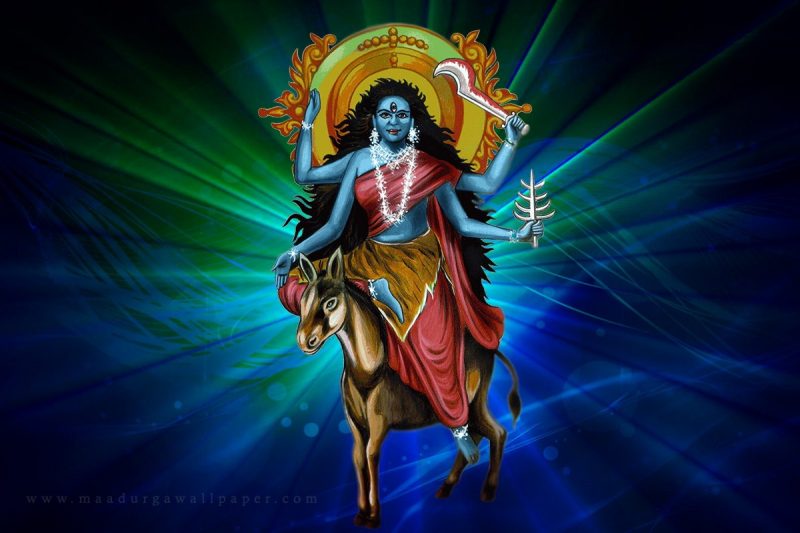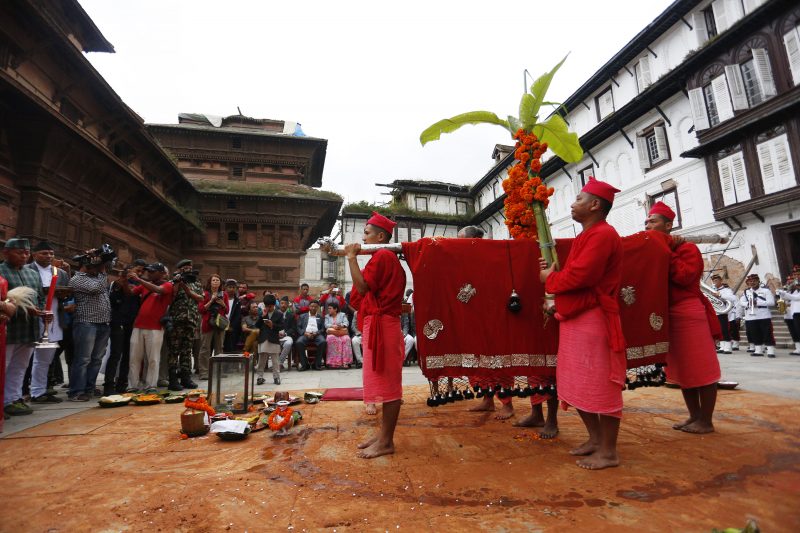Day 7: Fulpati
Day 7 Fulpati
After the 1st day of Dashain, the next most important is the 7th, also known as Fulpati. Today, the 7th form of the goddess Durga, Kaalratri, is worshipped. Kaalratri symbolizes one of the goddess’ most fierce and destructive forms of the Mother Goddess, described as the destroyer of all demon entities, ghosts, spirits and negative energies, “who flee upon knowing of her arrival.”
Her appearance is equally fierce. Kaalratri is described as having a dark image, which oddly enough appears blue, with eyes, mouth, and clothing the color of crimson. She has 4 arms: the two left hands hold a scimitar and a thunderbolt, while her right hands symbolize blessing and protection. Mounted on a donkey, Kaalratri bears a third eye, from which lightening is believed to emanate. Her jewelry shines like the moon. Associated with the crown chakra, Kaalratri is believed to give her invokers/devotees power, wealth, fearlessness, and knowledge.
“Ful” means flower, and “pati” means leaves/plants, so this is the day in which a collection of 9 plants and flowers are bundled together and brought into the shrine room of every home. These 9 plants represent different dieties and are placed in the room along with the pot of holy barley sprouts, the jamara, that was planted on the first day of Dashain. After a worship ceremony is conducted, both the fulpati (the bundle) and the barley seedlings are worshipped. Bringing the fulpati into the home is believed to bring health, wealth, and prosperity.

Ritual puja done after Phulapati being brought to Nasal chwok, Hanumandhoka during Phulapti Ceremony in the capital on Saturday. October 8, 2016. PHOTO/SANJOG MANANDHAR
On a much grander scale, a royal fulpati is created in Gorkha, a district 3-days journey from Kathmandu. A Magar priest escorts the fulpati to Kathmandu, where it is greeted by the Nepali army, police, and government dignitaries, and paraded in a golden palanquin until it reaches the residence of the president. The army gives it a rousing salute of continuous fire for 10-15min, indicating that the fulpati has been successfully received.
I know what you’re thinking. What do all of these things have in common? What could possibly the meaning of parading a bundle of foliage around? Well that, my friend, involves another tale of the goddess Durga.
The king of Gorkha in 1614 A.D. was Ram Shah and it was said that his queen was a goddess, known to be a goddess by her one devotee. One day, the king saw his queen in goddess form and died instantly. Throwing herself on her husbands’ funeral pyre (a practice known as sati), the goddess promised her devotee that she would return in her next life. 6 months later, a farmer discovers a stream of blood and milk as he plows his field. The devotee rushed to spot and performed rituals until the flow ceased. At this site, the Manakamana Temple is built and dedicated to the goddess Durga where only direct descendants of her one devotee can serve as priests. It is 6 of these Magar priests that escort the royal fulpati to the new center of governance in Kathmandu (upon Nepal’s unification) to invoke the blessing of the goddess Durga.
__________________________________________________________________________________________________________________________________
http://www.weallnepali.com/about-nepal/historic-places/manakamanatemple
http://www.weallnepali.com/nepali-festivals/saptami-and-phulpati
https://en.wikipedia.org/wiki/Dashain
https://en.wikipedia.org/wiki/Kaalratri
